
Atlas F1 Technical Writer
Having won every Championship going into the new millenium, where can the Ferrari technical team go now? Atlas F1's Technical Writer Craig Scarborough attended the team's 2004 launch earlier this week and took a closer look at the F2004 to see what the future holds. He also received exclusive information from Technical Director Ross Brawn on the new gearbox
Gearbox
Ferrari has been working hard at reducing gearbox length and weight in order to shift more weight and space forward, as well as to improve stiffness, gear change speed and longevity. Having come from a fabricated titanium casing and carbon bell housing to cast titanium a few years ago, this year sees a further development following the lines pioneered by Jordan, which has also been adopted by another undisclosed F1 team.
There are many problems encountered by the two different needs of the chassis designer and gearbox designer. One requires a stiff structure to mount to the rear of the engine; placing the suspension loads into the engine provides a low desk to damper and torsion bar mountings, with small dimensions, low weight and a high differential to clear the diffuser.
The gearbox designer also wants a stiff structure to house the bearings to mount the gear shafts onto, but suspension loads and the demands of aerodynamic profiles do not matter to him.
While the cast internal bulkhead supporting the bearings is plenty strong enough, the need to support the point loads of a suspension mounting requires a thicker casting, and hence more weight. Another drawback of aluminium castings in particular is it softens when hot, making the stiffness of the material for suspension loads even less desirable.
Ferrari and Renault have used a split case, where the upper suspension mountings are on a carbon moulding; while keeping the lower gearbox case in metal have proved satisfactory the need to join the two halves together adds some weight and complexity. A few teams have developed successful all carbon fibre casings; with metal bulkheads yet these are still in a relatively early stage of development, having been dropped from use by Stewart (Jaguar), Arrows and latterly McLaren.
Almost a by-line to the leading edge of gearbox design is an issue affecting Jordan last year, with their aluminium casing on the EJ13. As the casing was suffering cracks around suspension mounting points the ever pragmatic engineer Gary Anderson had carbon fibre bonded to the outer side of the casing to reinforce the area. When it was realised this was also very effective at stiffening the gearbox; the team wrapped most of the casing in a skin of carbon fibre (pictured). This process was also successful as the carbon did not need any moulds produced, and the bond between the two materials was well understood.
Layout
In contrast to expectations Ferrari have not changed the wheelbase by any significant margin; their press release quoting a figure of only 3050mm. Even the distribution of its dimensions between the gearbox, engine and chassis are of the same order as the F2003GA. It was accepted that the F2003GA's long wheelbase lead to weight distribution issues for the Bridgestone tyres. So in order to regain the preferred forward weight distribution, the team have sought to lose even more weight from the rear with the new gearbox and suspension layout.
Aero
If the car appears conventional and recognisable from the F2003GA it is because the wings and bargeboards are still the 2003 items. Everyone from the team was keen to point out that significant departures from these designs will appear in testing before Melbourne. At this time the parts have been designed and are undergoing the manufacturing process.
Overall the car is in keeping with the Ferrari philosophy of maintaining the aerodynamic envelope tight to the body with the sidepod undercuts and hot air outlets, the reverse of the blow it high and wide around the car (i.e. chimney) approach adopted by other teams.
This transition of undernose to sidepod flow is also aided by the deeper undercut on the leading edge of the sidepod, recognisable as being deeper as the floor outboard of the sidepods is now so wide. The coke-bottle shape of the sidepods is similar in sweep and width; with only the flip up now being angled upwards, apparently designed to split the air passing under the nose from that passing over the sidepods, keeping the flow to the rear nice and clean.
The cooling outlets have been further developed, with two small scalloped outlets on the airbox cover, smaller exhaust fairings and V-shaped outlets formed at the end of the sidepods. There is still a panel on the sidepod shoulder to install the distinctive "shark grills" to tune the cooling at warmer races.
It is the fairing around the gearbox that also sees more extreme development; the suspension is now so low and neat that little shaping is required to cover the set up. Small shrouds are moulded into the fairing to cover the pushrod and wishbone mountings, but otherwise the fairing has shrunk to blend the rear profile of the engine into the tail structure. The fairing is so well wrapped around the gearbox that the sidepods cooling outlet can flow over the top of the gearbox, and the driveshafts have protrude through slots rather than having a large cut-out. This level of design has been unique to Ferrari over the past few years.
It's no coincidence that the lower wing beam is very deep above the diffuser and acts to pull the flow through the tunnel. From looking at the upper side of the floor moulding where it joins the diffuser amps no obvious step could be seen. Ferrari have run a step between the flat and ramped sections as it picks up a rolling bubble of flow, which allows the flow under the car to remain attached as the floor ramps up into the diffuser. Brawn admitted this was not a definitive floor, suggesting the step would be carried over.
The lower beam also has deep sections on its outer edges with a full width gurney, suggesting this element is being worked hard to regain the downforce lost from the rear wing. This device is usually quite sensitive and tricky to get to work as well on the track as it does in the tunnel. Still, the very outermost chords of the beam have the deepest section, flattening the profile out to try to reduce tip vortices. As has the rear wing, which sees shorter chords where it meets the endplates, to reduce drag inducing vortices.
Mechanicals
Work on the electronic and cooling installations have been reviewed, and will continue to be examined in order to provide a quicker engine change should problems occur with a driver race chassis and he needs to switch himself and his (single) engine to the spare chassis.
This year's hybrid gearbox is even lower than last year, and designed solely for the Sachs radial dampers, whereas the 2003GA casing could run conventional or radial dampers. As a result the installation is incredibly low and compact, barely requiring bodywork shaping to shroud it. To the rear of the gearbox is a rear crash structure which has yet to pass its official FIA impact test; this could be related to the rear-end aero update due for Melbourne, so the shape of the launch car structure could change.
Engine
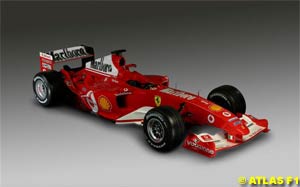 Having previously had radical, controversial and evolutionary launches this Ferrari launch was always going to be hard to predict; especially so with pre-launch comments regarding the front wing coming from the team, teasing that a new design was on the cards. When the covers were pulled on Monday at Maranello the similarity to the 2003 car was obvious, and perhaps disappointing, but disclosures by the team on major new aerodynamic parts and new gearbox materials, plus closer analysis of the car, suggest that Ferrari have more to come prior to Melbourne.
Having previously had radical, controversial and evolutionary launches this Ferrari launch was always going to be hard to predict; especially so with pre-launch comments regarding the front wing coming from the team, teasing that a new design was on the cards. When the covers were pulled on Monday at Maranello the similarity to the 2003 car was obvious, and perhaps disappointing, but disclosures by the team on major new aerodynamic parts and new gearbox materials, plus closer analysis of the car, suggest that Ferrari have more to come prior to Melbourne.
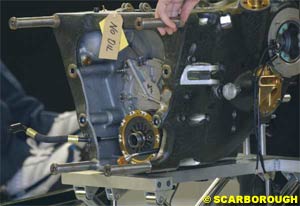 Chassis designers would prefer to choose carbon fibre, a material well known to them, to provide a high modulus of stiffness which is easily designed and manufactured in house. Yet gearboxes need accurate bearing locations, as the bearings and gears heat up the casing needs to expand with them; carbon fibre does not provide the same expansion as metals, so the gearbox designer would prefer steel, aluminium, magnesium or titanium.
Chassis designers would prefer to choose carbon fibre, a material well known to them, to provide a high modulus of stiffness which is easily designed and manufactured in house. Yet gearboxes need accurate bearing locations, as the bearings and gears heat up the casing needs to expand with them; carbon fibre does not provide the same expansion as metals, so the gearbox designer would prefer steel, aluminium, magnesium or titanium.
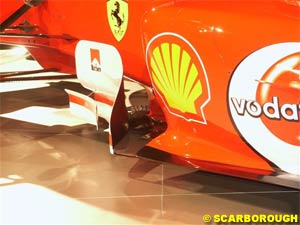 Ferrari have now adopted this process and applied carbon fibre reinforcements to the exterior of their titanium casting. Unlike Jordan (in 2003 at least) Ferrari have had the opportunity to design the strength of the hybrid structure from a clean sheet, choosing varying thicknesses of material where each is required. Fortuitously the softening and expansion of cast metals under heat is restrained by the tensile properties of the carbon fibre, potentially providing even greater stiffness for the whole unit as well as specific local stiffening.
Ferrari have now adopted this process and applied carbon fibre reinforcements to the exterior of their titanium casting. Unlike Jordan (in 2003 at least) Ferrari have had the opportunity to design the strength of the hybrid structure from a clean sheet, choosing varying thicknesses of material where each is required. Fortuitously the softening and expansion of cast metals under heat is restrained by the tensile properties of the carbon fibre, potentially providing even greater stiffness for the whole unit as well as specific local stiffening.
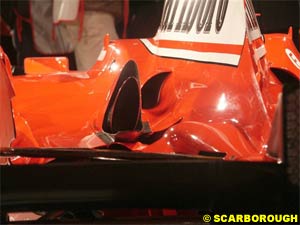 Definitive parts on the car are the nose and chassis shape, largely carried over from the old car; only the shape of the chassis just ahead of the sidepods has been altered to match the new sidepod inlets. The sidepods themselves are more extreme versions of the F2003GA; the inlets are now higher, creating a smooth path beneath them for the air passing from under the nose to flow along the flanks of the sidepods.
Definitive parts on the car are the nose and chassis shape, largely carried over from the old car; only the shape of the chassis just ahead of the sidepods has been altered to match the new sidepod inlets. The sidepods themselves are more extreme versions of the F2003GA; the inlets are now higher, creating a smooth path beneath them for the air passing from under the nose to flow along the flanks of the sidepods.
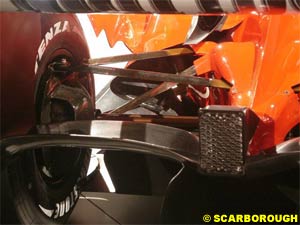 Rules demanding the engine cover meets a larger dimensional envelope have been met, with the cover continuing after the axle line with an awkward looking step that has not helped by the line of the Marlboro logo. While the floor was not a definitive moulding, the central diffuser tunnel is now so steep that is needs to be open topped to meet the bodywork dimensions in this area.
Rules demanding the engine cover meets a larger dimensional envelope have been met, with the cover continuing after the axle line with an awkward looking step that has not helped by the line of the Marlboro logo. While the floor was not a definitive moulding, the central diffuser tunnel is now so steep that is needs to be open topped to meet the bodywork dimensions in this area.
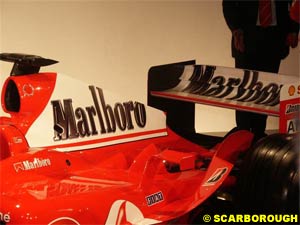 The front suspension does not outwardly appear to be a departure from the 2003GA, with conventional wishbone geometry (i.e. not dropped as with Michelin runners). The single keel design is carried over as Byrne and Ross Brawn still feel there is potential with this design; the compromise in structure and geometry do not warrant the aero gains. The steering system has been updated for drivers feel. The fuel cell is smaller and slimmer, and on either side the sculpted coolers remain installed at a compound angle, with the internal ducts feeding them for the sidepod faces also provide mountings and cooling for the cars various ECU's, which can be seen on the floor of the inlet ducts.
The front suspension does not outwardly appear to be a departure from the 2003GA, with conventional wishbone geometry (i.e. not dropped as with Michelin runners). The single keel design is carried over as Byrne and Ross Brawn still feel there is potential with this design; the compromise in structure and geometry do not warrant the aero gains. The steering system has been updated for drivers feel. The fuel cell is smaller and slimmer, and on either side the sculpted coolers remain installed at a compound angle, with the internal ducts feeding them for the sidepod faces also provide mountings and cooling for the cars various ECU's, which can be seen on the floor of the inlet ducts.
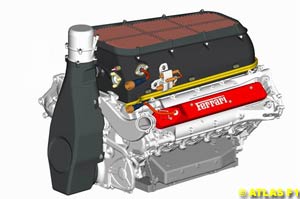 Under the lead of Paolo Martinelli and designed with Gilles Simon, the engine has been developed to meet the "one-engine rule". Little was added to the technical details; the V angle remains the same, with power output and rev ceiling of a similar order to the 2003 unit. Martinelli commented that not only the reciprocating parts needed redesigning to meet the new regulations, and as such the castings and ancillaries have been revised. Following on from Toyota comments that power loss over 800km was not regarded as reliability, Martinelli added that even 1% over the race distance was not acceptable.
Under the lead of Paolo Martinelli and designed with Gilles Simon, the engine has been developed to meet the "one-engine rule". Little was added to the technical details; the V angle remains the same, with power output and rev ceiling of a similar order to the 2003 unit. Martinelli commented that not only the reciprocating parts needed redesigning to meet the new regulations, and as such the castings and ancillaries have been revised. Following on from Toyota comments that power loss over 800km was not regarded as reliability, Martinelli added that even 1% over the race distance was not acceptable.
Please Contact Us for permission to republish this or any other material from Atlas F1.
|
Volume 10, Issue 4
Articles
The Alchemist
Interview with Rubens Barrichello
Technical Analysis: Ferrari F2004
A Visit to the Cat-House
2004 Countdown: Facts & Stats
Columns
Rear View Mirror
Bookworm Critique
Elsewhere in Racing
> Homepage |